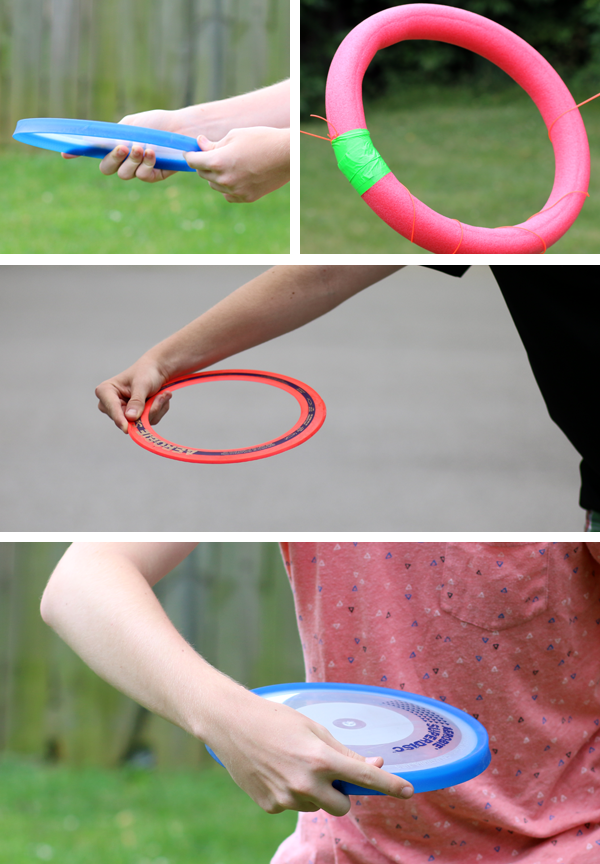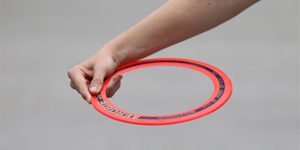Fun Frisbee Science
Test different throwing techniques or compare different types of Frisbees and learn more about aerodynamics and physics at the same time. Ready, set, throw!

With the right mindset—or source of inspiration—you can find ways to easily tie science into many of your family's activities and hobbies, and the things you do with your kids for fun can be a fulcrum for science-themed family conversation. Your kids don't even have to realize you are turning a routine together-time activity into a science exploration! Integrating science inquiry at home can be that subtle. What you might discover is that once you start asking general questions about why or how something works the way it does, your kids are excited and eager to talk about science, to hypothesize, to experiment, and to put various questions and ideas to the test.
Throwing Frisbee® is a classic beach or park pastime. With a simple disc of plastic, you and your kids can throw a Frisbee back and forth for hours. As in many sports, however, not all Frisbees are the same, and not all Frisbees are plastic! The kind of Frisbee you use may make a significant difference in how it throws. What kind of material is the Frisbee? What is its diameter? Is it a solid disc or a ring? How thick is the Frisbee? How heavy?
Basic properties of the Frisbee itself and of the process of throwing a Frisbee can lead to interesting questions. Does a 7" Frisbee fly the same distance as a 10" one? How does the flight of a disc compare to a ring? What is the best throwing stance? Can you throw as far with a forehand throw as you can with a backhand throw? What factors influence accuracy? How does the angle of the throw relate to the distance the Frisbee travels? How does a hammer throw really work?
These are science-based questions you can explore with simple side-by-side comparisons of different kinds of Frisbees and throws, so grab a few Frisbees and your game-on attitude and head to the park, a field, a school track, a basketball gym, or another space large enough to let you throw a Frisbee full force and see what you and your kids can discover about the aerodynamics and physics of Frisbee throwing.
Make Science Fun
A track can be a great place to do a Frisbee experiment because the lines on the track may make it even easier to measure distances. If you want to take precise measurements, you will need a measuring tape (or string) with you. But if general comparisons are sufficient, grab a few sticks of colored chalk and use a different color for each Frisbee type to mark off where each Frisbee throw lands. If you throw the same Frisbee a bunch of times and compare those throws to the same number of throws for another Frisbee, you will be able to see how the different Frisbees compare by looking at the colored chalk marks! (After doing all of your throws, you can then go back and measure the distance from the starting point to each chalk mark to make a more formal log of results for analysis.)
If accuracy, not distance, is being tested, you can make it a game by setting up an informal target. You can make a fancy target system, but a simple foam pool noodle taped together and suspended can work, as can a large plastic tarp with holes cut out for targeting. Assign point values to various rings or cutouts, and you have all the makings of an fun family challenge, with some science to explore at the same time.
Frisbee Science
The following projects and activities can help you create a fun family science Frisbee exploration at the park:
- The Aerodynamics of Flying a Frisbee
- The 'Ultimate' Science Fair Project: Frisbee Aerodynamics
- Why Do Aerobie Flying Rings Go So Much Further Than Frisbees?
- What A Drag!
These kinds of science activities may improve your Frisbee skills and your game of Ultimate. Will these help if you and your family play disc golf? Sure! But you may also find that learning more about trajectory, launch angle, and flight paths can make a difference in how you think about your next game of disc golf. Projects using the Ping Pong Catapult are a great way to explore these science principles (though not with disc golf discs). Plus, launching mini footballs, ping pong balls, or even plastic eggs through the air at a target can be a lot of fun! For another family science activity related to trajectory, see Throwing Balls and Trajectory.
View more Sports Science project ideas
Categories:
You Might Also Enjoy These Related Posts:
- 15 STEM Gifts & Science Kits You'll Feel Good About Giving
- 13 Boat Science and Submarine Science Projects and Experiments
- July 4th STEM! Summer Science Picks for Independence Day!
- 12 Science Kits for Summer Science Experiments and Discovery
- 15 Science Projects to Make and Give for Father's Day
- Ready, Set, Go! (Awesome Summer Science Experiments)
- Awesome Summer Science Experiments
- 10 STEM Activities with Cardboard Tubes










